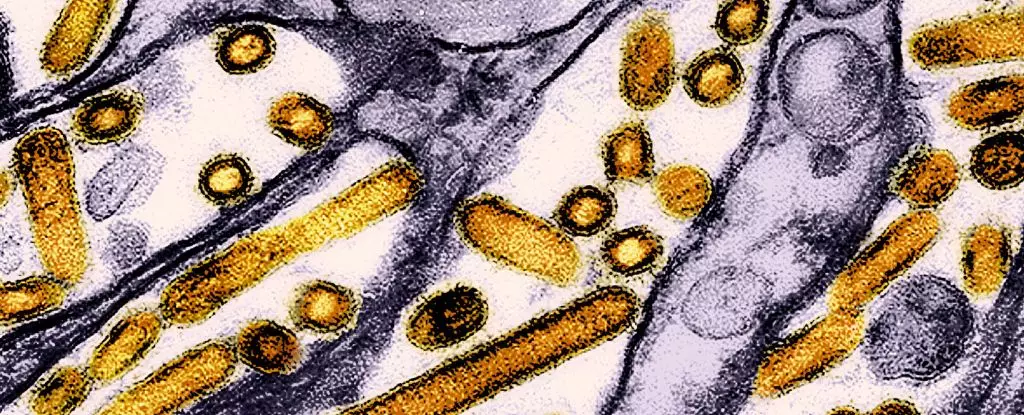Recent findings pose unsettling questions about the potential spread of bird flu among humans, particularly within the dairy farming community in the United States. Blood samples from 115 dairy workers across Michigan and Colorado reveal a silent, yet significant, occurrence of the highly pathogenic H5N1 strain of avian influenza among individuals who might otherwise consider themselves healthy. With 7 percent of those tested showing antibodies for this virulent strain, the implications for public health and agricultural practices become increasingly critical to assess.
Upon analyzing the results, it seems that many of these dairy workers, despite having contracted the virus, experienced only mild symptoms or none at all. Approximately half of these individuals reported no significant illness, suggesting a curious aspect of the infection’s clinical presentation. Symptoms reported included red, itchy eyes, fever, sore throat, congested nasal passages, sneezing, diarrhea, and headaches. The vast majority of the workers also had not employed the personal protective equipment (PPE) recommended for handling birds or environments infected with HPAI A(H5), raising questions about safety practices within this critical industry.
While the Centers for Disease Control and Prevention (CDC) maintains that the current risk to public health remains low, this situation should not be underestimated. Researchers caution that unchecked transmission of this virus stock could facilitate mutations leading to more virulent strains. This concern is amplified by events in other regions, such as Cambodia, where a hybrid strain of the bird flu has been responsible for several fatalities. Here we can see a clear path leading to heightened alertness; the potential for increased transmissibility among mammals could destabilize previously managed zoonotic diseases.
Amid all of this, Canada recently reported its first case of bird flu in a human, a teenager in critical condition, adding another layer of complexity to the narrative around H5N1. Genetic analyses reveal that this case involves a variant strain associated with the ongoing outbreaks affecting livestock in the U.S. The presence of a mutation that enhances the virus’s ability to infect humans is particularly troubling, making vigilant tracking and intervention imperative.
These growing concerns underscore the unpredictability inherent to infectious diseases, especially when the boundaries between animal and human infections begin to blur. The detection of a human case without a clear animal source is alarming, as it raises the specter of potential human-to-human transmission, a scenario that could herald unprecedented consequences for global health.
In light of this information, it becomes crucial to address the protocols and educational outreach necessary for dairy workers. The CDC notes that the workers in their study had limited exposure to recommended safety practices, which could explain the higher-than-expected levels of antibodies detected in this at-risk population. As a result, there is an urgent need to intensify training and outreach concerning infection prevention measures, particularly among Spanish-speaking workers who make up a significant portion of the agricultural labor force.
The responsibility lies not only with workers but also with employers to implement systems that prioritize employee safety and infection control. This includes reinforcing the importance of wearing appropriate PPE and reinforcing hygiene protocols to minimize risks in the workplace. Enhancing communication, outreach, and education is key to ensuring that vulnerable populations are informed about risks and educated about protective measures.
The ramifications of avian influenza extend beyond individual health; since 2022, over 90 million domestic birds have been culled in the U.S. to control the spread of the disease. Although efforts to vaccinate certain at-risk species, like California condors, have been initiated, the biological diversity affected by the ongoing outbreak requires a broader focus.
Simultaneously, researchers worldwide are exploring the potential for developing a human vaccine against avian flu. Such advancements could mitigate the risks and deepen our understanding of the interactions between different strains of viruses and their capacity for cross-species transmission.
In closing, the findings related to H5N1 antibodies among dairy workers serve as a warning to the agricultural sector and public health officials alike. Given the potential for rapid changes in the behavior and virulence of infections, a comprehensive, coordinated approach to monitoring and response becomes increasingly necessary. Vigilance, preventive measures, and educational outreach could be the linchpin in our efforts to contain potential outbreaks in a rapidly changing landscape. As the interface between human health and animal disease continues to evolve, proactive measures will be our greatest ally in ensuring collective safety amid this hidden threat.


Leave a Reply